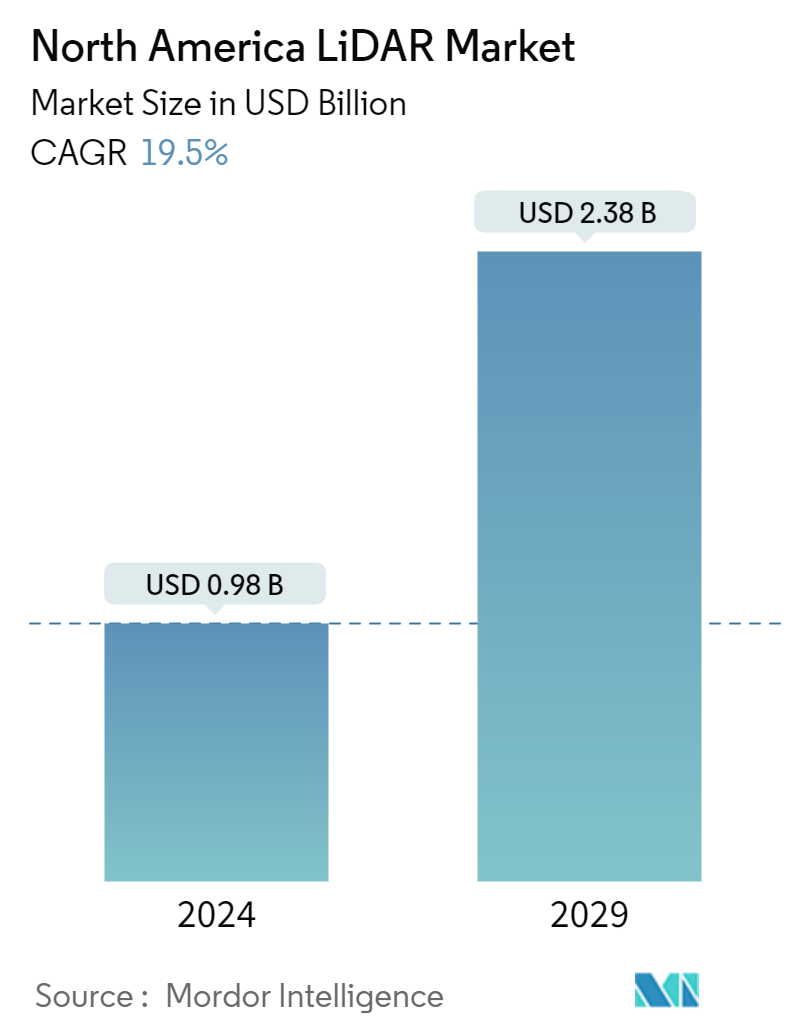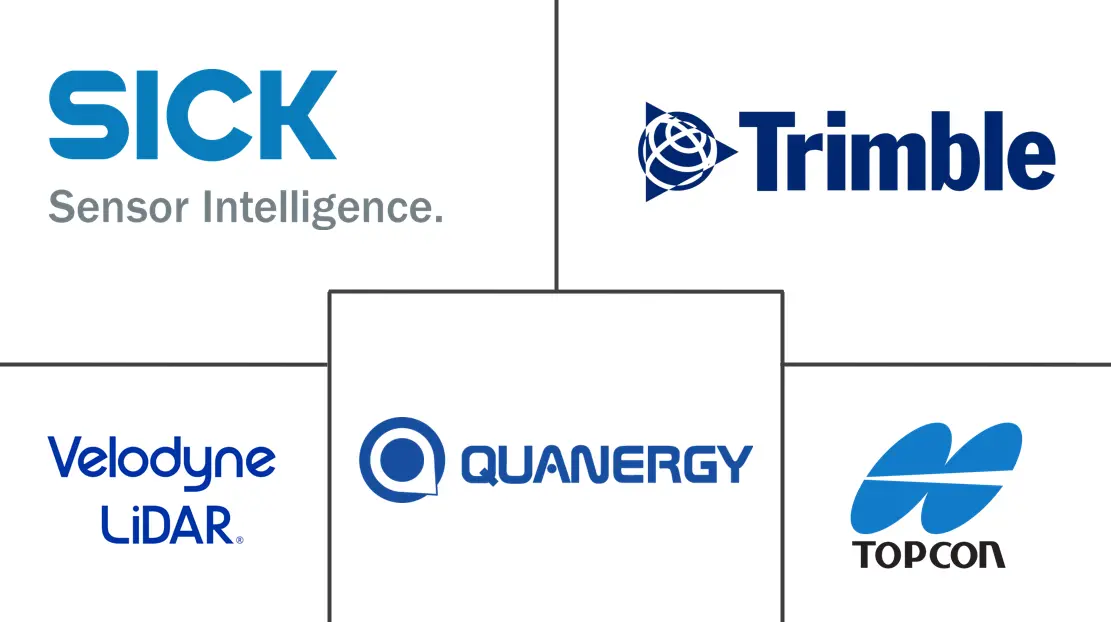Market Size of North America LiDAR Industry

| Study Period | 2019 - 2029 |
| Base Year For Estimation | 2023 |
| Market Size (2024) | USD 0.98 Billion |
| Market Size (2029) | USD 2.38 Billion |
| CAGR (2024 - 2029) | 19.50 % |
| Market Concentration | Low |
Major Players
*Disclaimer: Major Players sorted in no particular order |
North America LiDAR Market Analysis
The North America LiDAR Market size is estimated at USD 0.98 billion in 2024, and is expected to reach USD 2.38 billion by 2029, growing at a CAGR of 19.5% during the forecast period (2024-2029).
Moreover, the growing trends in the automotive industry toward self-driving cars and electric vehicles are expected to be critical drivers for newer applications of LiDAR.
- North America is one of the major developers of the technology, owing to increasing investments in accelerating innovations in the LiDAR landscape. These types of LiDAR systems are adopted by a growing number of industries, especially for applications in engineering, construction, the environment, and exploration, proving the effectiveness and, therefore, demand for this technology.
- Additionally, the growing demand for platooning in the North American region is also influencing the growth of this market. Following Georgia and Tennessee, Arkansas, North Carolina, South Carolina, and Texas have made commercial platooning legal, which enables freight companies like FedEx to conduct more fuel-efficient operations. As platooning needs technologies like LiDAR, it is therefore expected to contribute to the region's dominance in the automotive space for LiDAR technology.
- According to US Department of Transportation data, 51% of freight miles within the country are available in states that have approved commercial truck platooning. LiDAR technology is used in unmanned aircraft systems (UAS), and the US military and civil government are increasing their operations for UAS, which can increase the growth of this market.
- Moreover, ground-based LiDAR systems are witnessing growth, owing to factors such as low cost and their increasing applications in SUVs. The ground LiDARs provide an exceptional ability to produce 3D images of land in coastal and other areas, as well as ground movements such as landslides.
- However, the high costs associated with the deployment of this technology are restraining the growth of this market, and many manufacturers are looking for substitutes that could replace the functionality of LiDAR systems using RADAR and other optical sensors. Hence, these factors can restrain the growth of this market.
- Furthermore, the COVID-19 pandemic led to lockdowns all over the world, which disrupted the exports of automotive parts and caused large-scale manufacturing interruptions in the US.
North America LiDAR Industry Segmentation
LiDAR is a remote sensing method that uses light in the form of a pulsed laser to measure ranges by targeting a surface or an object with a laser and measuring the time for the reflected light to return to the receiver. The LiDARs are also used for tracking low-flying aircraft, as they can perform efficiently in all weather conditions and can accurately calculate the dimension and distance of the target.
The scope of the report covers the segmentation of LiDARs based on product type, components, end-user, and country. The study also tracks the key market parameters, underlying growth influencers, and major vendors operating in the industry, which supports the market estimations and growth rates over the forecast period. The study further analyzes the overall impact of COVID-19 on the ecosystem. The scope of the report encompasses market sizing and forecasting for segmentation by product, components, end-user, and country.
The market sizes and forecasts are provided in terms of value (USD million) for all the above segments.
| Product | |
| Aerial LiDAR | |
| Ground-based LiDAR |
| Components | |
| GPS | |
| Laser Scanners | |
| Inertial Measurement Unit | |
| Other Components |
| End-User | |
| Engineering | |
| Automotive | |
| Industrial | |
| Aerospace & Defense |
| Country | |
| United States | |
| Canada |
North America LiDAR Market Size Summary
The North America LiDAR market is poised for significant growth, driven by advancements in technology and increasing applications across various industries. The region is a key player in the development of LiDAR systems, with substantial investments fueling innovation. The automotive sector, particularly the push towards self-driving and electric vehicles, is a major contributor to the market's expansion. The demand for platooning, which requires LiDAR technology for efficient operations, is also boosting market growth. Additionally, the use of LiDAR in unmanned aircraft systems by both military and civil government entities is further propelling the market. Ground-based LiDAR systems are gaining traction due to their cost-effectiveness and diverse applications, such as producing 3D images for environmental monitoring.
Despite the promising growth prospects, the market faces challenges, including the high costs associated with LiDAR deployment, which has led some manufacturers to explore alternatives like RADAR and optical sensors. The COVID-19 pandemic also disrupted supply chains and manufacturing, impacting market growth. However, technological advancements in GPS and geospatial computing are enhancing LiDAR's capabilities, particularly in navigation and mapping applications. The market is characterized by a competitive landscape with numerous vendors investing in research and development to maintain an edge. Collaborations and strategic partnerships, such as those between Cepton Inc. and LidarSwiss Solutions GmbH, are indicative of the industry's focus on innovation and expanding applications in infrastructure management and autonomous driving.
North America LiDAR Market Size - Table of Contents
-
1. MARKET INSIGHTS
-
1.1 Market Overview
-
1.2 Industry Attractiveness - Porter's Five Forces Analysis
-
1.2.1 Bargaining Power of Buyers/Consumers
-
1.2.2 Bargaining Power of Suppliers
-
1.2.3 Threat of New Entrants
-
1.2.4 Threat of Substitute Products
-
1.2.5 Intensity of Competitive Rivalry
-
-
1.3 Industry Value Chain Analysis
-
-
2. MARKET SEGMENTATION
-
2.1 Product
-
2.1.1 Aerial LiDAR
-
2.1.2 Ground-based LiDAR
-
-
2.2 Components
-
2.2.1 GPS
-
2.2.2 Laser Scanners
-
2.2.3 Inertial Measurement Unit
-
2.2.4 Other Components
-
-
2.3 End-User
-
2.3.1 Engineering
-
2.3.2 Automotive
-
2.3.3 Industrial
-
2.3.4 Aerospace & Defense
-
-
2.4 Country
-
2.4.1 United States
-
2.4.2 Canada
-
-
North America LiDAR Market Size FAQs
How big is the North America LiDAR Market?
The North America LiDAR Market size is expected to reach USD 0.98 billion in 2024 and grow at a CAGR of 19.5% to reach USD 2.38 billion by 2029.
What is the current North America LiDAR Market size?
In 2024, the North America LiDAR Market size is expected to reach USD 0.98 billion.

